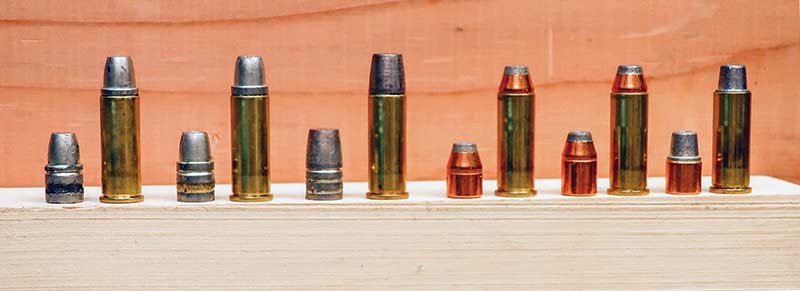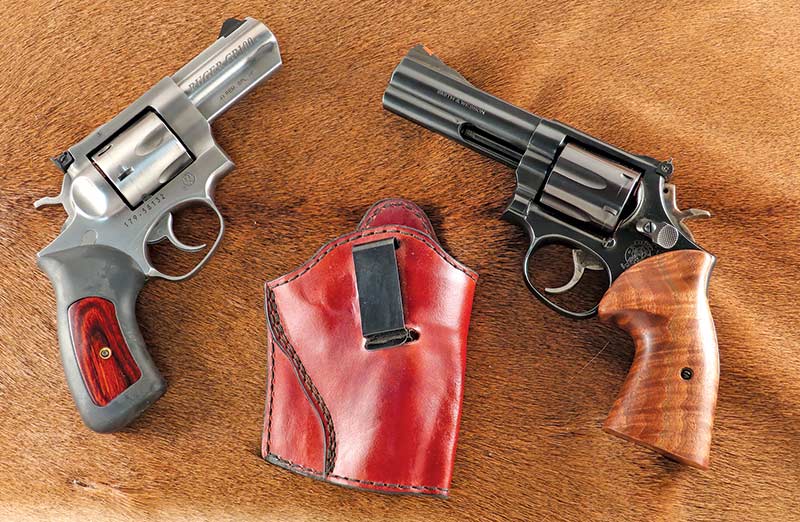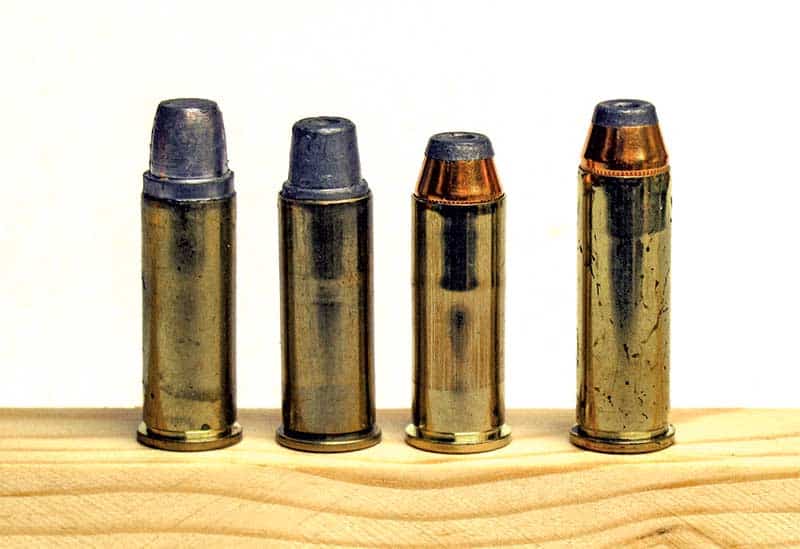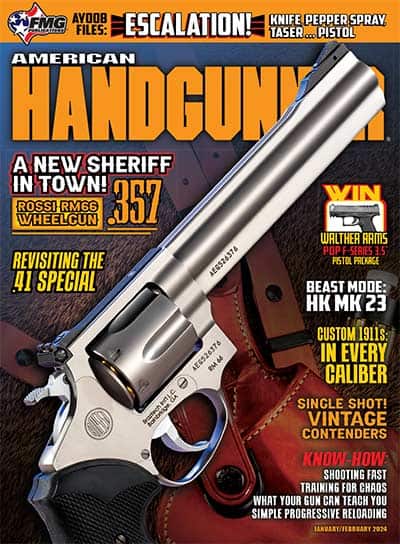Revisiting The .41 Special
The Very Special Specials, .38 and .44, both arrived in the first decade of the 20th century before WWI. The S&W revolver was originally designed to fire the .38 United States Service cartridge (.38 Long Colt). D.B. Wesson suggested the cartridge case be lengthened to allow the powder charge to be increased from 18 grains of black powder to 21.5 grains. The bullet weight was changed from 150 to 158 grains. This new cartridge was called the .38 S&W Special, and with the development of the new cartridge, the factory introduced the .38 Military & Police Model. No one could have foreseen this would be S&W’s most popular revolver, and now, 125 years later, it is still being produced. The same cartridge became the .38-44 Heavy Duty in the early 1930s and was then lengthened to become the .357 Magnum in 1935. A natural progression.
The first revolver in a lineup of S&W sixguns we now know as N-Frames was designed to handle a new cartridge, which came about by the increasing of 23 grains of black powder in the .44 Russian, lengthening the case and bringing the charge to 26 grains. The standard bullet was a 246 round-nose lead and the cartridge became known as the .44 Special. In the 1920s, Elmer Keith began reloading the .44 Special and spent the next 30 years trying to convince manufacturers to bring out his Heavy .44 Special load. Finally, in late 1955, Keith got even more than he had asked for as the .44 Special case was lengthened to become the powerful .44 Magnum. Again, a natural progression.
Split The Difference?
With the .38 Special and .44 Special both being introduced in a period of just over five years, it would’ve seemed natural to split the difference and also come out with the .41 Special. Colt had the .41 Long Colt, which could have been modified to become the .41 Special; however, it was not to be. There was no .41 Special. Several experimenters came very close.
In the 1920s, at least 10 years before the advent of the first official Magnum, the .357, gunsmith Cyril “Pop” Eimer was offering the .40 Eimer Special from his Joplin, Mo. gun shop. Eimer started with Colt Single Actions in either .38-40 or .41 Long Colt. These were neither .38s nor .41 but rather .40s, and they used the same 0.403″ barrels. It only required a new cylinder for his wildcat. The .40 Eimer Special, also known as the .401 Eimer, was made by shortening the .401 Winchester or .30-40 Krag rifle brass to 1.25″ and loaded with 200-grain bullets. At the time, “Fitz,” John Henry Fitzgerald (Mr. Colt) tried to interest his company in chambering the Colt SAA and New Service in Eimer’s .40 but to no avail.
Two well-known names to handloaders who use cast bullets and study the past, Gordon Boser and Ray Thompson, worked with the .40 caliber in the 1930s and 1940s. Boser was a Springville, N.Y. gunsmith whose favorite sixgun cartridge, as so many others at the time, was the .44 Special; however, he wanted more than the Colt Single Action offered with this chambering. Using .401 Winchester brass trimmed to 17/32″, he designed his own bullet, a 195-grain semi-wadcutter offered by Lyman as #401452. Ray Thompson would go on to design four excellent gas check bullets for Lyman. In 1932, Fred Moore, who was the Colt factory superintendent, chambered the Colt Official Police for the .41 Colt Special using 210-grain bullets at up to 1,150 fps. Remington even supplied the ammunition, and although they could’ve had a jump by three years on the S&W .357 Magnum, Colt declined to offer the .41 Colt Special.
First Modern Version?
Fast-forward to the 1980s. As far as I know, Hamilton Bowen was the first to produce a modern .41 Special. I supplied a 2nd Generation Colt Single Action, and Hamilton fitted it with a .41 Special non-fluted cylinder and a 5½” custom barrel. It proved to be a tack driver. He then did a second .41 Special for me on a S&W Model 586 by re-chambering the .357 Magnum cylinder and re-boring the barrel.
The third .41 Special done for me by Hamilton is one of the most beautiful single actions in existence. Starting with a Three-Screw Ruger .357 Flat-Top, he converted the cylinder and re-bored the 45/8″ barrel, finished it in a mouthwatering blue with case-hardened frame, hammer and trigger, and then it was fitted with beautifully grained exotic walnut stocks. Gary Reeder has supplied me with a well-named .41 Special which is the Perfect Packin’ Pistol of his design; and the late John Gallagher built .41 Specials on both Three-Screw and New Model Ruger Flat-Tops as well as an exquisite little .41 Ruger Single-Six with a five-shot cylinder. That brings us to today.
Current Undertakings
My friend Lane Pearce contacted Ruger, Hamilton and Remington with the idea of coming up with a true .41 Special along with factory ammunition. Ruger supplied six GP 100s, Hamilton did the conversion work and the hope was for Remington to supply the ammunition. Thus far, the first two steps have been completed and we can only hope for the third to be finalized. At the time, the only factory .41 Special ammunition I know of is a 215 SWC from Jamison.
I wanted adjustable sights and stainless steel, and Pearce, Ruger and Hamilton made it work. My prototype is on a 3″ GP 100 with its six-shot cylinder re-chambered to .41 Special and the original barrel bored out to .41 also. The right side of the barrel is marked in large letters, “RUGER GP 100,” and then under this on the lug, we have in smaller letters, “.41 REM. SPL. +P”. The rear sight is the standard Ruger adjustable, while the front sight features the Ruger interchangeable system. The standard front sight is a ramp black post, and I also have access to a gold bead front sight as well as nylon ramp sights in blue, white and yellow. Thus far, I have done most of my shooting with the standard front sight. The Bowen Conversion has performed flawlessly and is proven to be quite accurate.
Applications
There’s not much I can’t do that I need to do with a sixgun that cannot be handled with this Bowen Ruger .41 Special. With its shorter barrel and compact factory grips, it fits nicely in a Bob Mernickle inside-the-pants clip-on holster. This is a gun for the trail, whether that trail consists of concrete, sagebrush, foothills, forests, or mountains. It will handle anything short of big game hunting.
As a comparison, I looked at some muzzle energy figures of the .45 ACP. These are from a 5″ Model 1911 Colt with a closed breech. The standard 230-grain hardball at a muzzle velocity of 825 fps results in a muzzle energy of 340 ft-lbs. and .45 ACP + P loads are the same bullet at 950 fps, yielding 461 ft-lbs. Switching to the short 3″ barrel of the GP 100 with a barrel cylinder gap, these are easily duplicated using the Keith-style bullet. Using 6.5 grains of Unique gives approximately 850 fps, which is slightly more than a standard .45 ACP as far as muzzle energy is concerned, while 12.5 grains #2400 results in slightly more muzzle energy than the .45 ACP + P loads. I had expected the felt recoil of this .41 GP to be unkind to me. However, this was not the case, and the compact rubber grip did an excellent job even when I fired 300 rounds in one session.
Bullet Choice
For loading the .41 Special, I go with three cast bullets, Lyman #410459 KT, the Hensley & Gibbs 220 KT, the LFN 228 grain, and with three jacketed bullets consisting of the Sierra 170 and 210 Jacketed Hollow Cavities, and the Speer 200 SWC-HP. This latter bullet is the old-style consisting of a copper cup and a lead core. It was originally made in .38, .41 and .44 and is an excellent bullet. However, they are long out of production, and my stash is about gone. My powders of choice for the .41 Special are #2400. AA#9, #4227, Power Pistol, Unique, Universal and Red Dot. All loads utilize Winchester LP Primers for standard or magnum loads.
With this short-barreled .41, I shot all of my test loads at a self-defense distance of 10 yards. A couple I found outstanding and would definitely be chosen for everyday carry off the beaten path include both Keith bullets over 12.5 grains of #2400 with muzzle velocities over 950 fps and five-shot groups of 3/4″ while the same charge under the Sierra 210 JHC put five-shots in 5/8″. For loads in the standard .45 ACP category, 6.5 grains of Unique with the two Keith bullets gave muzzle velocities right at 850 fps and also placed five shots in 3/4″.
For a short while, the light burned brightly with the hope of a factory .41 Special sixgun and ammunition. Hopefully, that light is not now extinguished completely.











